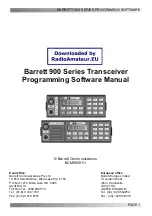
BGT24MTR11
User's Guide
Receiver Section
Application Note AN305, Rev. 1.0
2012-11-15
11 / 15
4.2
LO Section
BGT24MTR11 was designed to be used in monostatic radars. These radars are only capable of detecting a
target’s distance and speed, but not the angle of the target’s position relative to the antenna. It is possible,
though, to determine this angle when using additional RX-antennas and receiver chains. In this case the
BGT24MR2 offers two additional receiver chains in one package to build a system with three RX-antennas.
These external receiver chains need a local oscillator input which can be taken from BGT24MTR11’s LO output
(LO, pin 28).
In case the system needs one TX channel and two RX channels, Infineon offers BGT24MTR12 as a completely
integrated device especially for that application.
The LO pin may also be used as an alternative TX output in case the minimum TX output power is still too high
for the intended application. It must be noted, however, that the LO output can not be disabled unlike the TX
output.
If the proposed off-chip compensation structures described in the datasheet are implemented, the LO output
has a load impedance of 50
.
The typical output power of the LO pin is 0 dBm if the LO buffer is set to high output power mode. This can be
done by setting bit 4 (PC2_BUF) of the SPI register to HIGH. In low output power mode the output power is
reduced by 3.5 dB.
In case the LO output is not required, this pin can be left open.
5
Receiver Section
BGT24MTR11’s receiver section consists of two major blocks, the low noise amplifer (LNA) and the mixer.
5.1
Low Noise Amplifier
The LNA has a single-ended RF input with a port impedance of 50
, provided that the suggested off-chip
compensation structures are present on the PCB.
It is possible to reduce the LNA’s gain by setting SPI data bit 15 (GS) to high. The gain is then reduced by 6 dB.
5.2
Mixer
BGT24MTR11 features a homodyne quadrature downconversion mixer. RF input is provided by the LNA and
the LO signal is taken from the VCO’s output, isolated by a buffer amplifier. A RC polyphase filter is used for LO
quadrature phase generation.
The mixer converts the 24 GHz signals directly down to zero-IF and offers differential in-phase and quadrature
IF output signals. Each port has an impedance of 800
and may be connected directly to loads greater than
10 k
. Low ohmic loads need to have an coupling capacitor in place as there is a DC-voltage present at each
IF-output. This DC-voltage is typically 2.3 V with an offset of ±0.2 V depending on the received power and the
amount of LO leakage in the system. The maximum AC-swing, resulting from an RX signal with a power level
close to the LNA’s input compression point is 0.6 V peak-peak. When deeply in saturation the AC-swing can go
up to 1 V peak-peak.

































